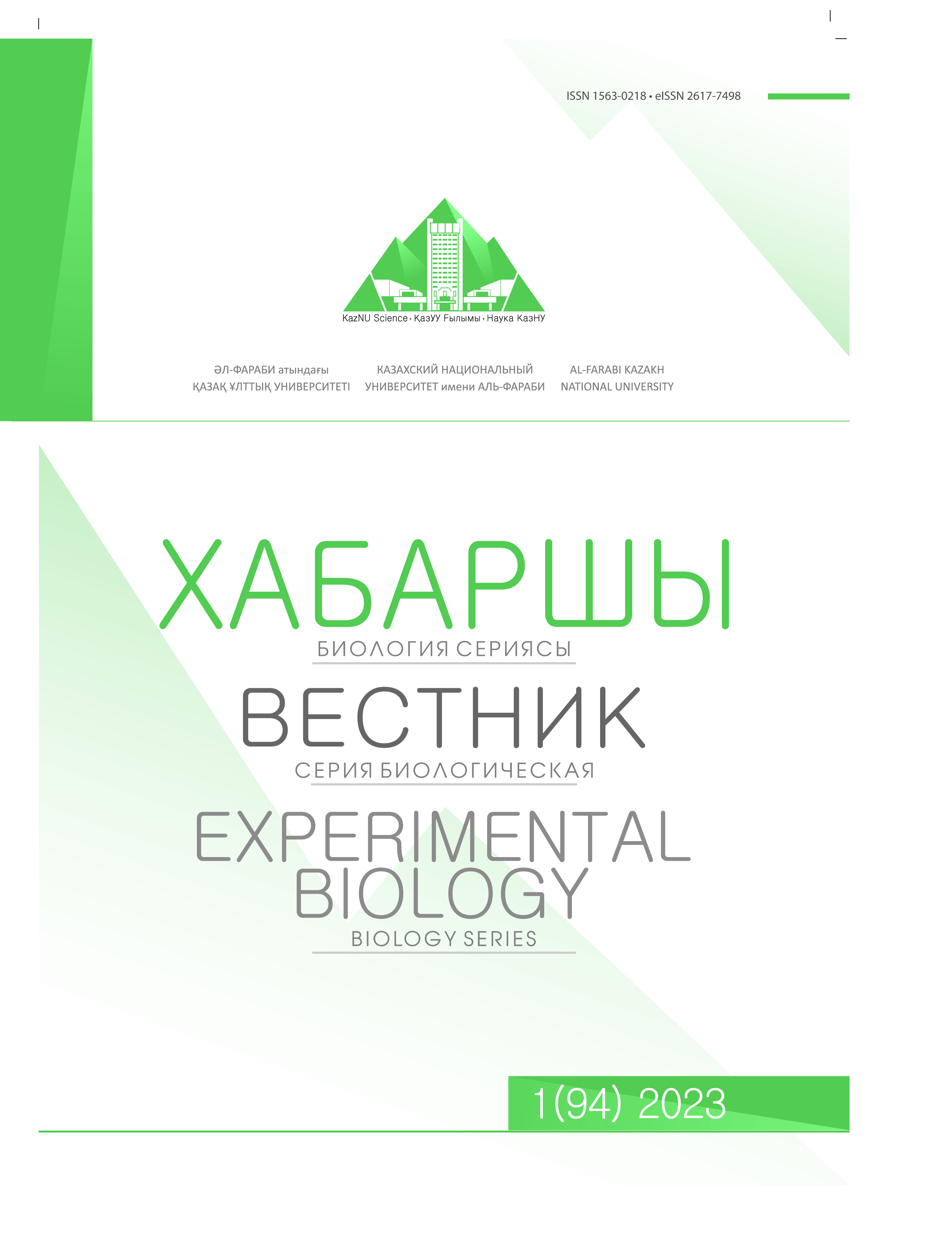PHYTOSANITARY MONITORING OF COTTON PESTS
DOI:
https://doi.org/10.26577/eb.2023.v94.i1.01Abstract
The article describes the work on the route calculation of pests that occur in the cotton field sown in different periods in the practice of peasant farms of Turkestan region. In a directional study, it was found that the cotton moth settled in cotton fields on an average of 1 m2 – 0.5-2 pieces. In the conditions of the Turkestan region, 18-20 pieces per 100 plants were found in the cotton crop, when exceeding the threshold of economic harmfulness against pests Dimilin 48% s.k., (0.1 L/ha), Tagrel e.k., (1.5 l/ha); Lyatrin e. k., (0.5 l/ha); Petra 5% e.k., (0.5 l/ha); Karate, 050 e.k., (0.5 l/ha) ha) spraying was carried out. The prevalence of cotton root rot was 1.5% -11%, the development was 1.0 - 12%, and the prevalence and development of cotton gommosis was 1-3%.
References
Alpysbaeva K.A., Abzeitova E.A. The use of beneficial angiosperms against cotton moth (Helicoverpa armigera Hbn.), the main pest of cotton in South Kazakhstan // Zh. Searches, results. Almaty. 2012. – No. 4. – P.42-47.
Alpysbaeva K.A., Abzeitova E.A. Use of Bracon (Bracon hebetor Say.) bioagent to protect cotton crop from cotton moth in South Kazakhstan. // J. Herald. Almaty. 2013 – No. 12. – P. 16-18.
Amanzholov R.A., Ashikbaev N.Zh., Alpysbaeva K.A. and other Biological method of plant protection in Kazakhstan. // J. Bulletin. -Almaty. -2011. -No. 11. -S. 39-45.
Aslam, M., Razaq M., Rana, S. and Faheem, M. 2004. Efficacy of different insecticides against bollworms on cotton. Journal of Reseach Science, 15(1): 17–22.
Byrne D.S. Whitefly biology / Byrne D.S., Wellows T.S. // Ann. Rev. Entomol.-1991.-voh 36. – P.431-457.
Dospekhov B.A. Methodology of field experience (with basics of statistical processing of research results). 5th edition re- vised and supplemented – M.: Agropromizdat, 1985. – P.351.
Faradzheva S.A., Gumbatov O.M. Brakon: breeding and application // J. Plant Protection. – M. 1995. – No. 3. – P. 16-17.
Hassanpour, M., Mohaghegh, J., Iranipour, S., Nouri-Ganbalani, G. and Enkegaard, A. (2011). Functional response of Chrysoperla carnea (Neuroptera: Chrysopidae) to Helicoverpa armigera (Lepidoptera: Noctuidae): Effect of prey and predator stag- es. Insect Science, 18: 217-224.
Iskendirova R. A. pests of agricultural crops. – Almaty, 2017. – P.242.
Ismukhambetov zh. d., Sagitov A. O., Dyusembekov B. A. recommendations for biological protection of cotton crops in South Kazakhstan from harmful butterflies.// – Almaty, Bastau. -2011. – P.28.
Ismukhambetov zh. D.number and composition of entomoacariphages of food agrocenosis in South Kazakhstan. Material of the international scientific conference “protection of crops and environmental sustainability of agrocenoses”. “No,” she said. 2014. – P.71-72.
Khan M. A. Integration of Selected Novel Pesticides with Trichogramma chilonis (Hymenoptera: Trichogrammatidae) for Management of Pests in Cotton / J. Agr. Sci. Tech. (2019) Vol. 21(4): – P.873-882
Khan, R.R., Ashfaq, M., Ahmed, S. and Sahi, S.T. 2009. Mortality responses in Bracon hebetor (Say) (Braconidae: Hy- menoptera) against some new chemistry and conventional insecticides under laboratory conditions. Pak. J. Agri. Sci. 46(1):30-33.
Lettmann J, Mody K, Kursch-Metz TA, Blüthgen N, Wehner K. Bracon wasps for ecological pest control-a laboratory ex- periment. PeerJ. 2021;9:e11540. Published 2021 May 27. doi:10.7717/peerj.11540
Lian-Sheng Zang, Su Wang, Fan Zhang, Nicolas Desneux. Biological Control with Trichogramma in China: History, Present Status, and Perspectives. Annual Review of Entomology 2021 66:1, – P.463-484
Murray D. A. H., Rynne K. P., Winterton S. L. Bean J. A., Lloyd R. J.Effect of Host Plant on Parasitism of Helicoverpa armigera (Hübner) (Lepidoptera:Noctuidae) by Hyposoter didymator Thunberg (Hymenoptera: Ichneumonidae) and Cotesia kazak (Telenga) (Hymenoptera: Braconidae). Australian Journal of Entomology. –Volume. 34, Issue 1. –2004. – P. 71–73.
Ombaev A. M., Aldabergenov K. I., Abishev I. A.Umbetov I.”The system of development of agricultural production in Turke- stan region”. – Almaty: Start. 2006. – P.15.
Razinataj, M., Jokar, M., Mojeni, T., Heravi, P., Haghnama, K., Abravan, P. (2020). Evaluation of the Effectiveness of Some Synthetic Insecticides Against Cotton Bollworm, Helicoverpa armigera Hübner (Lepidoptera: Noctuidae). Egyptian Academic Jour- nal of Biological Sciences. A, Entomology, 13(4), 141-146. doi: 10.21608/eajbsa.2020.122635
Saad, A.S.; Tayeb E.H.; Awad, H.A. and Abdel Rehiem, A.S. (2015): Trichogramma evanescens release in correlation with certain pesticides against the spiny Bollworm, Earias insulana (Boisd.) (Lep., Noctuidae) infestation in early and late cotton cultiva- tion. Middle East Journal of Applied Sciences, 5(1): 290-296.
Sagitov A. O., Ismukhambetov zh. d., Koishibayev M. K., Iskak S. A. methodological recommendations on accounting and detection of particularly dangerous investors and rural areas. – Almaty, 2003. – P. 195.
Sagitov A.O., Ismukhambetov Zh.D., Recommendations for the biological protection of cotton against cutworms in the south of Kazakhstan, Almaty-Rakhat. 2011 – P.3-23.
Sagitov A.O., Jumakhanov B.M., Alpysbaeva K.A. Use of biological agents against the cotton moth, a cotton pest. Interna- tional scientific-practical conference. Shymkent. 2011. – P.36-37.
Shah, N., Ganguli. J., Bhowmick, A. K., & Jaiswal, S. K. (2021). Comparison of the Life Cycle Related Parameters of Bracon hebetor say on Helicoverpa armigera Hubner Reared on different Hosts. Biological Forum – An International Journal, 13(1): 602-606.
Shuping Luo, Steven E. Naranjo, Kongming Wu. Biological control of cotton pests in China / Biological Control 68 (2014) 6–14
Thomson L.J., Hoffmann A.A. Laboratory fecundity as predictor of field success in Trichogramma carverae (Hymenoptera: Trichogrammatidae) / J.econ.Entomol.- 2002.- Vol.95-N 5. – P.912-917.
Umbetaev I. technology of ventilation of new domestic varieties of bellows in the south of Kazakhstan. – Almaty: Start. 2005. – P.12.












